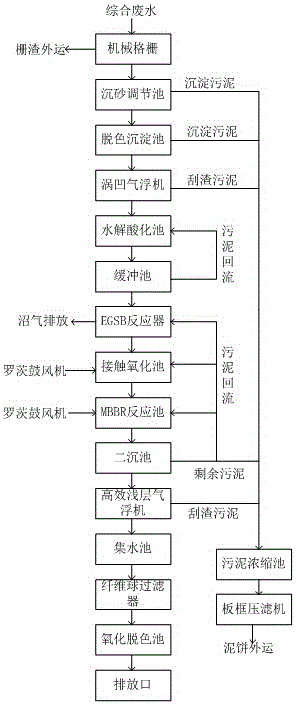Printing and dyeing waste water treatment process
A kind of printing and dyeing wastewater, treatment process technology
- Summary
- Abstract
- Description
- Claims
- Application Information
AI Technical Summary
Problems solved by technology
Method used
Image
Examples
Embodiment 1
[0076] The composition of the above-mentioned flocculant includes: 8 parts of ferrous sulfate, 6 parts of polyacrylamide, 4 parts of lignosulfonate, 5 parts of alum, 3 parts of polyferric silicon, 6 parts of polyferric sulfate chloride, 3 parts of animal glue, Sodium alginate 5 parts.
Embodiment 2
[0078] The composition of the above-mentioned flocculant includes: 5 parts of ferrous sulfate, 3 parts of polyacrylamide, 2 parts of lignosulfonate, 3 parts of alum, 2 parts of polyferric silicon, 10 parts of polyferric sulfate chloride, 5 parts of animal glue, Sodium alginate 8 parts.
Embodiment 3
[0080] The composition of the above-mentioned flocculant includes: 10 parts of ferrous sulfate, 8 parts of polyacrylamide, 5 parts of lignosulfonate, 7 parts of alum, 5 parts of polyferric silicon, 4 parts of polyferric sulfate chloride, 2 parts of animal glue, Sodium alginate 4 parts.
PUM
| Property | Measurement | Unit |
|---|---|---|
| surface load factor | aaaaa | aaaaa |
Abstract
Description
Claims
Application Information
 Login to View More
Login to View More - R&D
- Intellectual Property
- Life Sciences
- Materials
- Tech Scout
- Unparalleled Data Quality
- Higher Quality Content
- 60% Fewer Hallucinations
Browse by: Latest US Patents, China's latest patents, Technical Efficacy Thesaurus, Application Domain, Technology Topic, Popular Technical Reports.
© 2025 PatSnap. All rights reserved.Legal|Privacy policy|Modern Slavery Act Transparency Statement|Sitemap|About US| Contact US: help@patsnap.com


